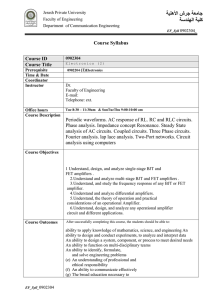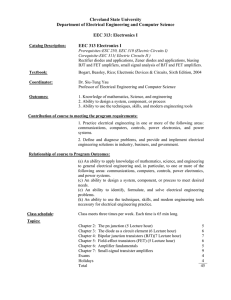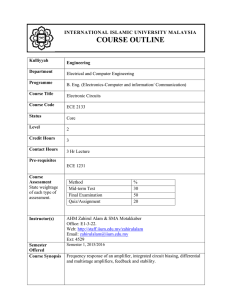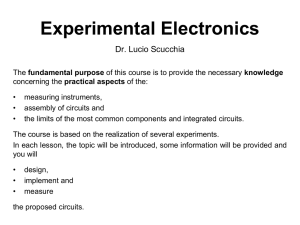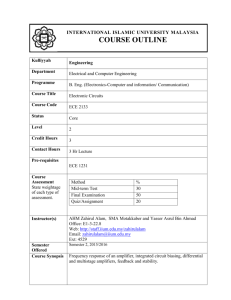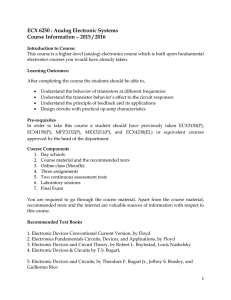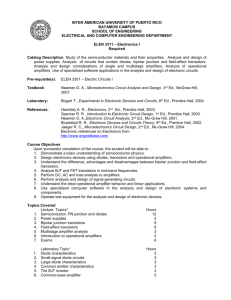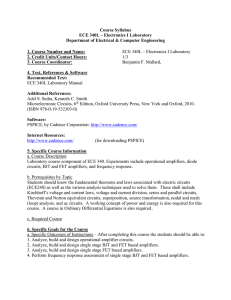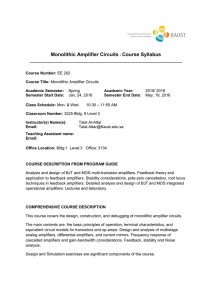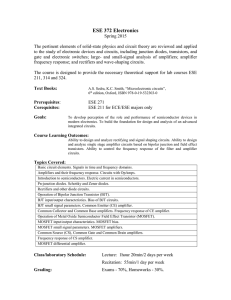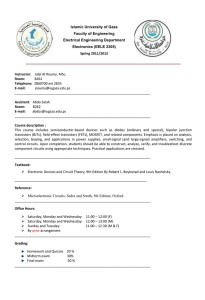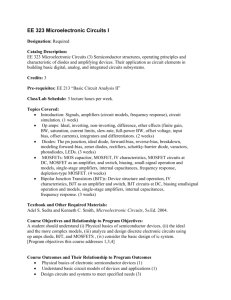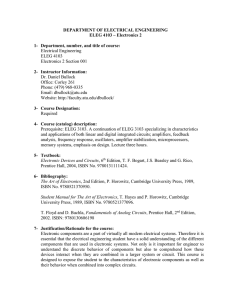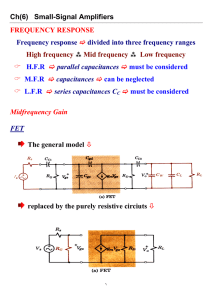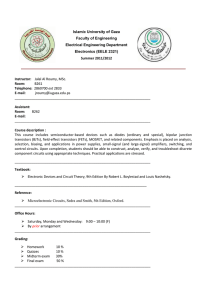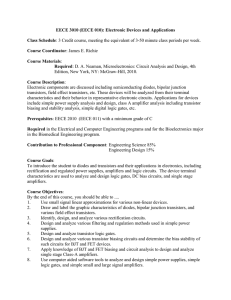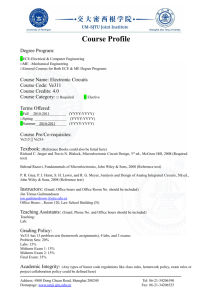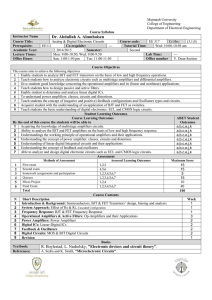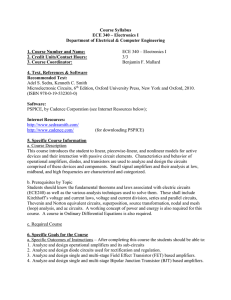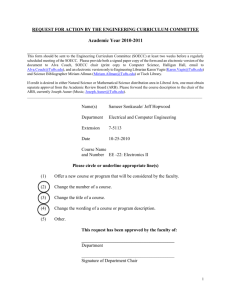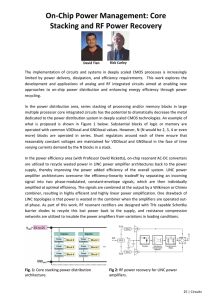Template for Self-Study Report - 2011-12
advertisement
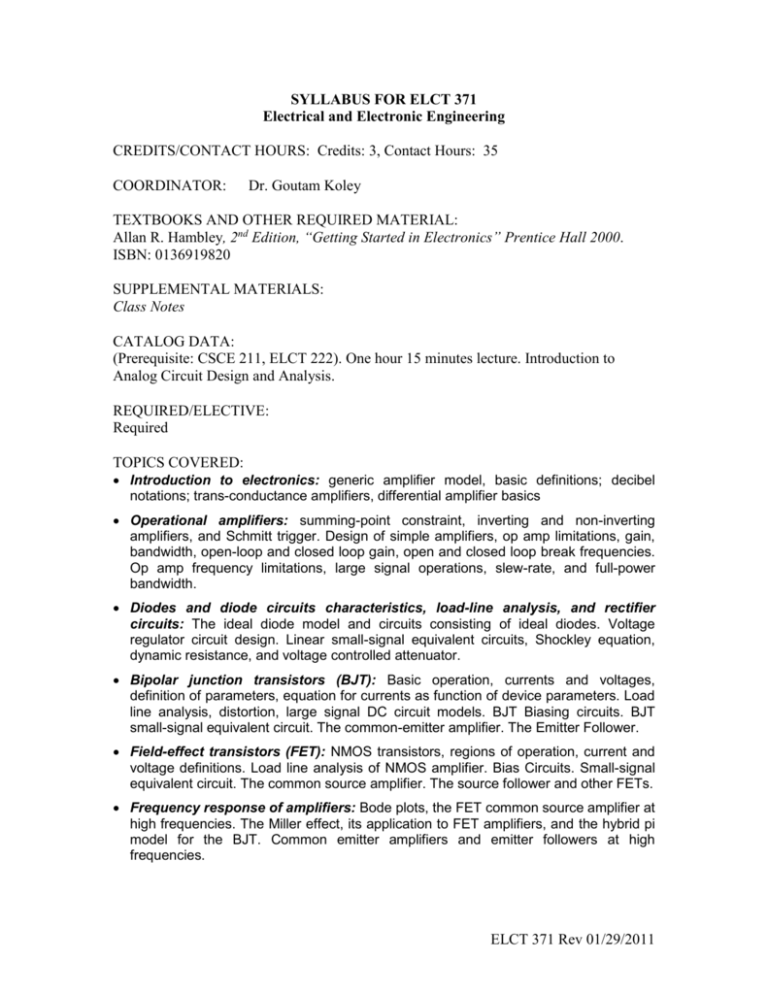
SYLLABUS FOR ELCT 371 Electrical and Electronic Engineering CREDITS/CONTACT HOURS: Credits: 3, Contact Hours: 35 COORDINATOR: Dr. Goutam Koley TEXTBOOKS AND OTHER REQUIRED MATERIAL: Allan R. Hambley, 2nd Edition, “Getting Started in Electronics” Prentice Hall 2000. ISBN: 0136919820 SUPPLEMENTAL MATERIALS: Class Notes CATALOG DATA: (Prerequisite: CSCE 211, ELCT 222). One hour 15 minutes lecture. Introduction to Analog Circuit Design and Analysis. REQUIRED/ELECTIVE: Required TOPICS COVERED: Introduction to electronics: generic amplifier model, basic definitions; decibel notations; trans-conductance amplifiers, differential amplifier basics Operational amplifiers: summing-point constraint, inverting and non-inverting amplifiers, and Schmitt trigger. Design of simple amplifiers, op amp limitations, gain, bandwidth, open-loop and closed loop gain, open and closed loop break frequencies. Op amp frequency limitations, large signal operations, slew-rate, and full-power bandwidth. Diodes and diode circuits characteristics, load-line analysis, and rectifier circuits: The ideal diode model and circuits consisting of ideal diodes. Voltage regulator circuit design. Linear small-signal equivalent circuits, Shockley equation, dynamic resistance, and voltage controlled attenuator. Bipolar junction transistors (BJT): Basic operation, currents and voltages, definition of parameters, equation for currents as function of device parameters. Load line analysis, distortion, large signal DC circuit models. BJT Biasing circuits. BJT small-signal equivalent circuit. The common-emitter amplifier. The Emitter Follower. Field-effect transistors (FET): NMOS transistors, regions of operation, current and voltage definitions. Load line analysis of NMOS amplifier. Bias Circuits. Small-signal equivalent circuit. The common source amplifier. The source follower and other FETs. Frequency response of amplifiers: Bode plots, the FET common source amplifier at high frequencies. The Miller effect, its application to FET amplifiers, and the hybrid pi model for the BJT. Common emitter amplifiers and emitter followers at high frequencies. ELCT 371 Rev 01/29/2011 COURSE OUTCOMES: 1. Demonstrate ability to design, analyze, simulate the performance of basic analog circuits (a, k) 2. Demonstrate a broad understanding of the applications of analog circuits in modern technological solutions (h, j) 3. Communicate effectively in the language of electronic systems, including correct understanding and use of technical terms (g, k) 4. Demonstrate an understanding of professional and ethical issues that arise in engineering practice (f) Relation of course outcomes to program outcomes: H = major importance, M = moderate importance, L = minor importance, blank indicates no relation Program Outcomes 1 an ability to apply knowledge of math, science and eng. (a) an ability to function on multidisciplinary teams (d) an understanding of professional and ethical responsibility (f) an ability to communicate effectively (g) the broad education necessary to understand the impact of engineering solutions (h) a recognition of the need for, and an ability to engage in life-long learning (i) a knowledge of contemporary issues (j) an ability to use the techniques, skills, and modern eng. tool necessary (k) 2 3 4 H M M H M M H H ASSESSMENT METHODS: 1. Exams: Midterms (2) and Final 2. Homeworks (6) 3. Quizzes (4 - 5) ELCT 371 Rev 01/29/2011
